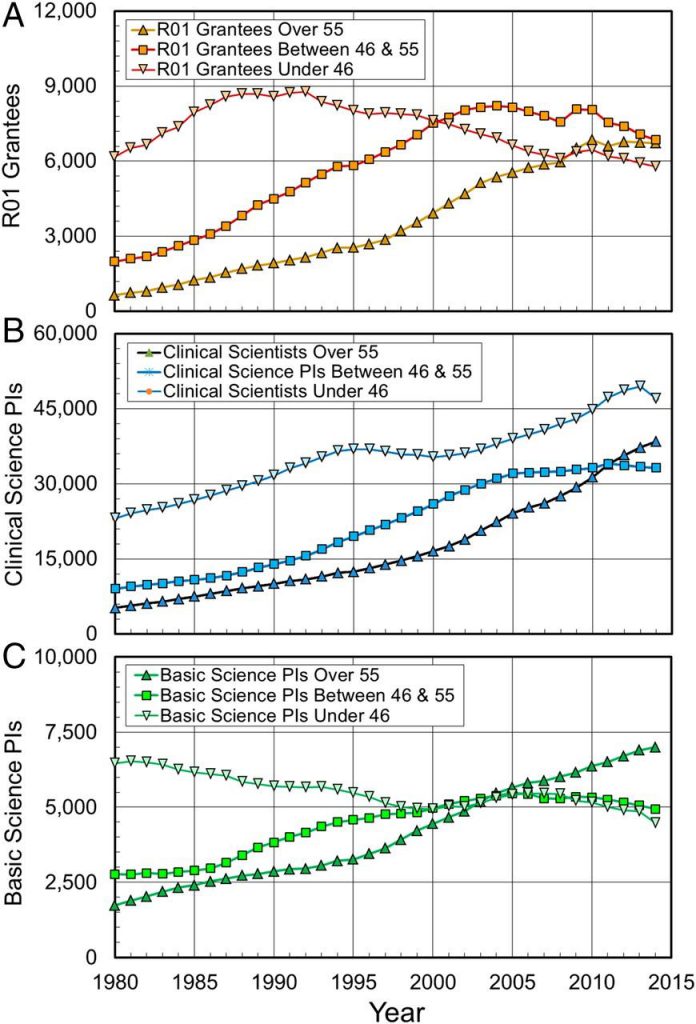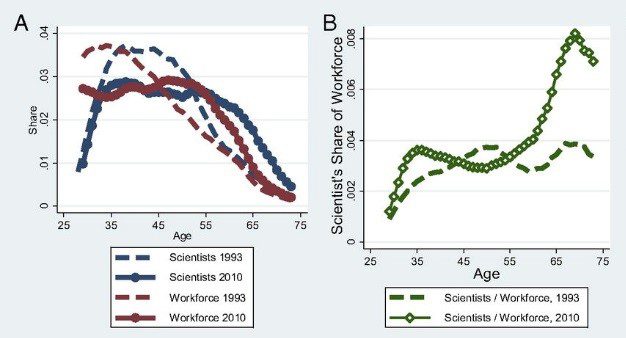1 Comments
As NIH continues its work to better understand the many factors that influence the stability of the biomedical workforce, we wanted to take a moment to discuss some recent papers that highlight the need to take new measures to support early and mid-career researchers.
Earlier this year, we discussed a paper by our NIH colleagues who looked at data on the shifting demographics of lead principal investigators (PIs) on NIH and National Heart Lung and Blood Institute (NHLBI) research project grants. One of their findings is a decline in the representation of PIs aged 41-55. A recent paper by Michael Levitt (Stanford University) and Jonathan Levitt (Statistical Cybermetrics Research Groups) published in the Proceedings of the National Academy of Science supports these observations. The authors combined NIH data on R01-funded PIs and Association of American Medical Colleges (AAMC) data on U.S. medical school faculty to examine trends among three age groups: over 55, between 46-55, and under age 46. The number of medical school faculty and NIH R01 grantees over age 55 has increased steadily since 1980. Focusing on faculty in basic science departments, the authors see a similar trend to NIH R01 grantee data, where the representation of younger and middle aged PIs has remained stagnant, or declined, since 2000.
Looking at inflation-adjusted funding data, the authors see further evidence that NIH-supported PIs under age 55 are feeling greater pressure. Funding markedly increased for PIs aged 46-55 and over 55 at the time of the NIH doubling, but for PIs under 46 funding remained comparatively flat.

From 2004 to present, we see that funding to PIs under 46 and 46-55 is declining, while funding to PIs over 55 remains relatively flat. In Panel C the authors present the data in a way that seems to show a large net transfer of funding to R01 grantees over 55.

In 2008, NIH implemented the early stage investigator (ESI) policy, and data shown in this paper shows a modest effect of the ESI policy, with younger basic science PIs seeing more success in achieving funding, beginning in 2010. The authors argue that NIH should provide younger investigators with greater support, enough additional support to restore the age distribution of basic science PIs closer to that seen in 1980. Their model proposes that by adding 2,255 basic science PIs in the younger cohort (45 and younger) the enterprise would achieve a steadier distribution of scientists across all ages, now and in the future.
David Blau and Bruce Weinberg (both from Ohio State University) describe in PNAS other factors that influence the age distribution of the scientific workforce. They used National Science Foundation and US Census Data to show that the aging of the scientific research workforce cannot be solely attributed to wider demographic changes; in other words, it’s not just that the population as a whole is aging. In 1993, there was relatively little association between age and the proportion of the general workforce made up by scientists. In 2010, the situation is decidedly different – with scientists over age 55 making up a greater proportion of the general workforce. The authors’ models suggest that the elimination of mandatory retirement in 1994 played a substantive role in these changes.

The authors examined other factors – including rate of PhD completion, changes in mortality, and representation of foreign-born PhDs in the US workforce – and found that these factors have little impact on the steady state distribution of the scientific workforce. By determining the rate at which individuals transition from scientific employment to non-employment, and modelling the implications of these rates on the future workforce, they predict an even further, and substantial, increase in the aging of the scientific workforce over the coming years.
Besides stabilizing in the scientific research enterprise, why else might we be interested in the data presented in the Charette, et al., Levitt & Levitt, and Blau & Weinberg papers? There are data that show the benefits of funding investigators of all ages. In a November 2016 Science paper, and February 2017 Science essay, Sinatra et al. present data on the careers and pattern of major discoveries of a broad group of scientists. Among computer science faculty, the most highly productive years – as measured by published papers – occurs within 8 years of starting their laboratory. However, among most scientists, including those in the life sciences, highest impact discoveries are not concentrated in the early-career stage, but rather are randomly distributed across early, mid, and late stage researchers. The authors argue that they “offer empirical evidence that impact is randomly distributed within the sequence of papers published by a scientist, implying that temporal changes in impact during a scientific career can be explained by temporal changes in productivity, luck, and the heavy-tailed nature of a scientist’s individual impact distribution.” This evidence suggests value for policies that offer funding support for scientists across all career stages.



I do not disagree with the conclusions of this article in principle but…. Even in the current climate, NIH statistics show that fewer than half of young investigators who are awarded an R01 will EVER get a second (ie competing renewal or a new grant). Since the available funding is not really expanding (particularly as measured by number of R01s awarded), I am very concerned that pushing even more preferential funding to new investigators will mean that second R01 rate will fall further. This has several negative implications to both the biomedical workforce and these individuals. First, academic organizations will be incentivized to expand their faculty further with young investigators, incurring major costs as the start up packages for new hires is typically in the high six figures and packages of over 1 million dollars are becoming quite common. Since it takes at least two R01s for organizations to recoop this startup in indirect costs, this means organizations are more likely to be making unproductive investments. Second, is the negative impact to the over all career of these scientists. If these scientists are in soft money positions, this means that these folks will find themselves out of a job in their early 40s when they do not get that second R01, and will find it difficult to land an equivalent position in industry, because they 1) have no industry experience and 2) industry is reluctant to hire folks too long in academia due to the cultural disconnect. Since the sequester, I know of many scientists in this position, and they often end up way under employed for their education and skills. If these scientists are in hard money positions in basic science departments, they may have gotten tenure with the single R01, but then the lack of funding will shutter their lab, and they will be permanent associate professors with the “dead wood” moniker. Even today, basic science departments across the nation are littered with such faculty who got their first R01 during the NIH doubling but could not continue to compete afterwards, particularly during the sequester…… Everything NIH does, even things that seem on the surface as good, have unforseen consequences. Seeing what negative results have come from preferentially funding of young investigators at even the current level has done already to institutions and the careers of scientists, I urge NIH to tread carefully here to not exacerbate an already acute problem. I know there has been talk of creating an “early established” investigator category, but that only will push the problem down the line, and make it worse for scientists since it will just mean that folks in their late forties/early fifties will find themselves unemployed when their soft money position lapses because they fail to get a third R01 award, which will just make their employment options even sparser.